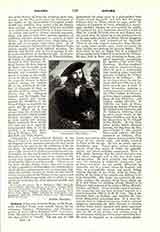

Sodoma
(GIOVANNI ANTONIO BALLI, or DE’BALLI, often miscalled Razzi, more usually known by his nickname, SODOMA), Piedmontese and Florentine painter, b. at Vercelli in Piedmont, 1477; d. at Siena, 1549. His father, Giacono da Bazzi, was a shoemaker who had settled in Vercelli. The son was in 1490 apprenticed for seven years to a glass-painter from Casale, named Spanzotti, and with him the young Sodoma went to Milan, where he came under the influence of Leonardo da Vinci, although it is exceedingly doubtful whether he ever entered his studio. He executed his first important decorative work in 1503 for a small Olivetan convent near Pienza, and, two years after, he passed on to the mother-convent of the same order, known as Monte Oliveto Maggiore, to continue the work commenced by Signorelh. There he not only painted twenty-five large frescoes, but many other smaller ones; these constitute his most notable and perhaps his greatest works. Two years later he was at Rome, one of a number of artists employed by Julius II to decorate the Vatican. He then went to Siena, and, returning to Rome, executed important commissions for Agostino Chigi in the Villa Farnisena. Having completed that work he returned to Siena, where he spent a considerable time, painting some wonderful pictures, including his “Christ Bound to the Column“. We do not know where he was between 1518 and 1525, but in the latter year he was at work at fresco decoration, painting a world-renowned panel, now in the Uffizi Gallery at Florence, with its almost unapproachable figure of San Sebastian; and various smaller pictures. In 1526 he was back at Siena, painting his famous frescoes in the Chapel of St. Catherine and St. Domenico, following them by other fresco works in the Palazzo Pubblico, and then by his decorations in the Chapel of San Spirito. It was these latter works which obtained honors for him from the Emperor Charles V, who created him a count palatine. He then wandered to Volterra, Pisa, Lucca, and various other places, leaving behind him traces of fine artistic work, and finally returned to Siena in his old age. He was an erratic and extraordinary man. Vasari gives various malicious reports about him, many of which are palpably untrue, and others probably exaggerated. There is little doubt, however, that his moral character was not above reproach and at the very least coarse and lascivious. He drew perfectly, and with great ease, his coloring is delightful, sumptuous, and at times sensuous; he was greatly influenced by Leonardo, and to a certain extent by Raphael, and there is a remarkable charm and poetic feeling running through all his works, while at times the beauty of the faces of his women and children is almost irresistible. His works are scattered all over Italy, perhaps the greatest being those which are at or near Siena, the painting already alluded to in Florence, and examples of his work at Milan, Munich, London, and Rome. Every possible scrap of information respecting him has been gathered together in a memoir issued in 1906 by R. H. H. Cust. This is the standard book on Sodoma, and contains the very latest information concerning him. It is more important than his original statements, to form a proper judgment concerning the artist, because it contains all that Vasari states, together with many important documents and new pieces of information, dealing with the life of the painter, and refuting many of the statements which have been made concerning him. He must be regarded as an extraordinary genius, because at times he reached the very highest of his ideals, and then at times completely failed. He must also be regarded as a man against whom many writers have thrown mud, and who now can be safely considered as a far greater man than his contemporaries regarded him, and not so evil in disposition as many were prepared to believe him to be.
GEORGE CHARLES WILLIAMSON

